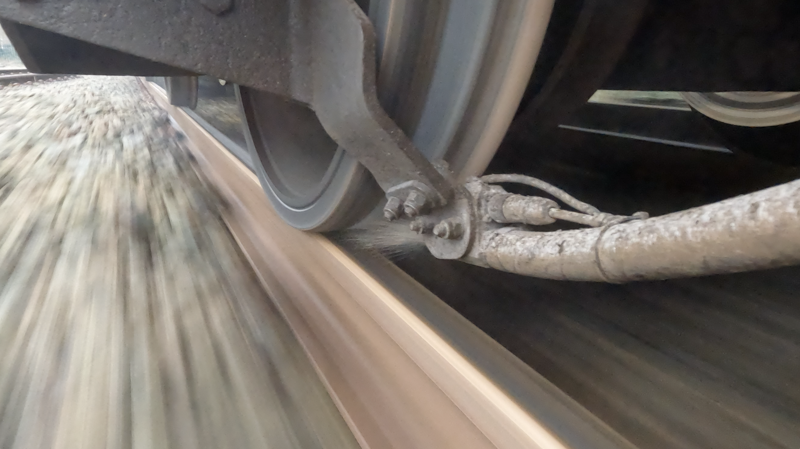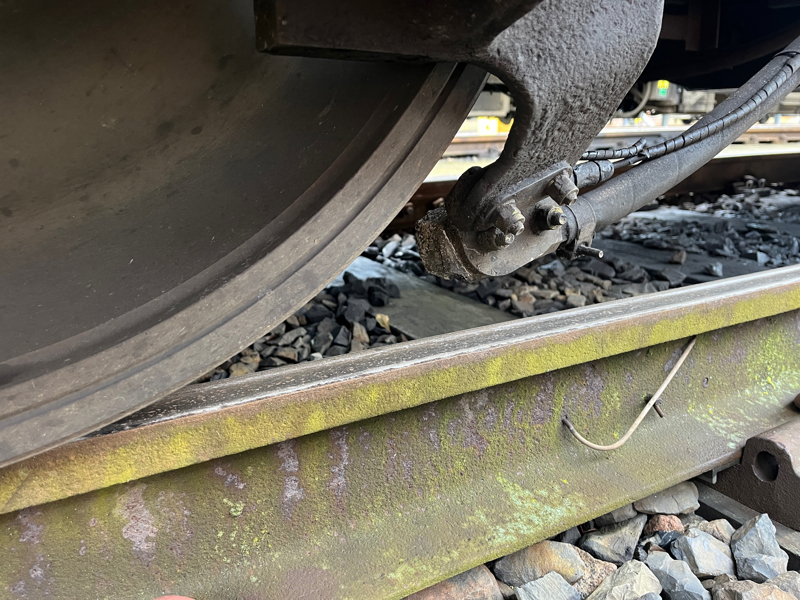
New equipment to improve braking on slippery rails has been fitted to all 39 Class 158/159 trains at South Western Railway’s Salisbury depot.

New equipment to improve braking on slippery rails has been fitted to all 39 Class 158/159 trains at South Western Railway’s Salisbury depot.
They are the same type of train involved in October’s crash at Talerddig in Wales (RAIL 1021), and in a crash at the entrance to Salisbury tunnel in 2021 (RAIL 944).
In both incidents, trains passed signals set at danger, moving into the path of another service. Poor adhesion in areas known for heavy leaf fall was a major factor in each crash.
The new equipment has been developed by Siemens and funded by Network Rail. It pours up to five kilos of sand a minute onto the rails, in front of the wheels, to improve grip. That is double the quantity of earlier systems. The sand is released at a variable rate under braking, depending on the speed of the train and condition of the track.
When leaves are crushed into a thin black coating, the head of the rail becomes like Teflon. The contact patch between a train wheel and the rail is the size of a five pence coin. Even with brakes fully on, the wheels can slide across the rail, unable to stop.

“The sand increases the friction level between the wheel and the rail. The greater the friction, the better the braking,” explained SWR Engineering Director Neil Drury.
“These trains originally weren’t fitted with sanders at all,” he added.
“The first generation was a single shot - the driver used it in an emergency. Next was a standard-rate sander. This third generation is variable. It makes an incremental difference.”
Tests by the Rail Safety and Standards Board show it can stop a train in slippery wet rails in half the distance of previous equipment, one quarter the distance of a train with no sanding at all, and double the distance of a similar train braking in ideal conditions on dry rails.
It is the first time the new sand applicators have been fitted to passenger trains.
Would they have prevented or reduced the impact of the Salisbury and Talerddig crashes?
“It’s a pertinent question. I can’t tell,” said Drury.
“The conditions at Salisbury were really difficult. The top of the rail surface was particularly contaminated. What we can say is that the sand system is much more effective than was fitted previously.”
Sambit Banerjee, joint chief executive of Siemens Mobility, said: “Our cutting-edge variable rate sanding technology optimises the rate at which sand is spread, significantly enhancing braking performance in challenging conditions.”
The investment has more than doubled the total number of trains treating the tracks in Network Rail’s Southern Region.
They are in addition to 25 existing specialist Railhead Treatment Trains used daily in the region to clear leaf mulch between October and December each year.
SWR runs a revised timetable during autumn, allowing extra time for drivers to brake more slowly. Its Salisbury fleet of 30-year-old diesel trains operate the West of England line between London Waterloo and Exeter, as well as services through Romsey and occasionally between Salisbury and Reading.
The technology was highly commended in the Innovation of the Year category at RAIL’s 2024 National Rail Awards, where judges said it has great potential for trains across the whole network.
The sanders tackle the effect of poor adhesion, rather than the cause. Three years on from the crash that was caused by leaves on the line, the approach to the Salisbury tunnel is still in a densely-wooded cutting of self-seeded deciduous trees and bushes.
“Autumn is a really challenging time, particularly on this route, which has large amounts of leaf fall,” said Network Rail spokesman Rob Breckon.
“We do a lot of things to tackle it, including chopping down trees as part of our programme of vegetation management.
“But we have to do that in a responsible way, and it is not possible to cut down every tree that lines the railway. It’s about a whole-system approach, and we are working with SWR and Siemens to deliver the improved sanding as part of that.”
Login to continue reading
Or register with RAIL to keep up-to-date with the latest news, insight and opinion.

















Login to comment
Comments
No comments have been made yet.